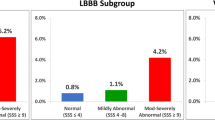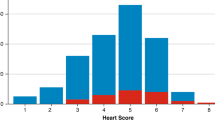Abstract
Background
Patients considered for electrophysiologic study (EPS) are often first referred for stress myocardial perfusion scintigraphy (MPS) to assess for inducible ischemia before testing. The purpose of this investigation was to determine the utility of this approach by examining the relationship between MPS and any interim cardiac catheterization and revascularization, as well as the results and safety of EPS.
Methods and Results
All patients undergoing EPS within 30 days after MPS at our institution between January 1997 and June 2000 were studied. Two hundred fifty-one patients met the inclusion criteria. The incidence of inducible sustained monomorphic ventricular tachycardia at EPS (IND) was 16%. One hundred twenty-nine patients had MPS ischemia (83 with high-risk features), but only twelve patients in all underwent revascularization between MPS and EPS. There were no ischemic complications during EPS. The presence of isolated ischemia on MPS was associated with a low rate of IND, not different from normal MPS findings (2%-3%). The combination of infarct and ischemia on MPS was associated with a high rate of IND that was similar to infarct alone (34% and 50%, respectively; P = .28).
Conclusions
Patients with high-risk MPS results are more likely to undergo revascularization before EPS than patients with low-risk or normal MPS results. However, most patients with high-risk MPS results undergo EPS without interim revascularization, and no patient had an ischemia-related complication at EPS. Larger studies will be required to confirm this observation. MPS infarct, not ischemia, is associated with IND at EPS.
Similar content being viewed by others
References
Miller JM, Coppess MA, Altemose GT, Gervacio-Domigo G, Scott LR. Management of postinfarct ventricular tachycardias. Cardiol Clin 2000;18:293–307.
Buxton AE, Hafley GE, Lehmann MH, et al. Prediction of sustained ventricular tachycardia inducible by programmed stimulation in patients with coronary artery disease. Circulation 1999;99:1843–50.
Gradel C, Jain D, Batsford WP, Wackers FJT, Zaret BL. Relationship of scar and ischemia to the results of programmed electrophysiological stimulation in patients with coronary artery disease. J Nucl Cardiol 1997;4:379–86.
Garcia EV. Imaging guidelines for nuclear cardiology procedures. J Nucl Cardiol 1996;3:G1–46.
American Society of Nuclear Cardiology. Imaging guidelines for nuclear cardiology procedures, part 2. J Nucl Cardiol 1999;6:G47- 84.
Steingart RM, Hodnett P, Musso J, Fuerman M. Exercise myocardial perfusion imaging in the elderly. J. Nucl Cardiol 2002;9:573- 80.
SAS software, version 8.1. Cary (NC): SAS Institute; 2001.
Gregoratos G, Cheitlin MD, Conill A, et al. ACC/AHA guidelines for implantation of cardiac pacemakers and antiarrhythmic devices. J Am Coll Cardiol 1998;31:1175–206.
Moss AJ, Zareba W, Hall WJ, et al, Multicenter Automatic Defibrillator Implantation Trial II Investigators. Prophylactic implantation of a defibrillator in patients with myocardial infarction and reduced ejection fraction. N Engl J Med 2002;346:877–83.
Kelly P, Ruskin JN, Vlahakes GJ, et al. Surgical coronary revascularization in survivors of prehospital cardiac arrest: its effect on inducible ventricular arrhythmias and long-term survival. J Am Coll Cardiol 1990;15:267–73.
Brugada J, Aguinaga L, Mont L, et al. Coronary artery revascularization in patients with sustained ventricular arrhythmias in the chronic phase of a myocardial infarction: effects on the electrophysiologic substrate and outcome. J Am Coll Cardiol 2001;37:529–33.
Morady F, DiCarlo LA Jr, Krol RB, et al. Role of myocardial ischemia during programmed stimulation in survivors of cardiac arrest with coronary artery disease. J Am Coll Cardiol 1987;9:1004–12.
Sellers TD, Beller GA, Gibson RS, Watson DD, DiMarco JP. Prevalence of ischemia by quantitative thallium-201 scintigraphy in patients with ventricular tachycardia or fibrillation inducible by programmed stimulation. Am J Cardiol 1987;59:828–32.
Cinca J, Blanch P, Carreno A, et al. Acute ischemic ventricular arrhythmias in pigs with healed myocardial infarction: comparative effects of ischemia at a distance and ischemia at the infarct zone. Circulation 1997;96:653–8.
Kowey PR, Friehling TD, Kline RA, Engel TR. Pacing-induced angina pectoris and induction of ventricular arrhythmias in coronary artery disease. Am J Cardiol 1986;58:90–3.
Tisselli A, Pieri P, Moscatelli G, et al. Prognostic value of persistent thallium-201 defects that become reversible after reinjection in patients with chronic myocardial infarction. J Nucl Cardiol 1997;4:195–201.
Gioia G, Bagheri B, Gottlieb CD, et al. Prediction of outcome of patients with life-threatening ventricular arrhythmias treated with automatic implantable cardioverter-defibrillators using SPECT perfusion imaging. Circulation 1997;95:390–4.
Author information
Authors and Affiliations
Corresponding author
Rights and permissions
About this article
Cite this article
Coleman, K.A., Steingart, R.M., Pollack, S. et al. Utility of stress myocardial perfusion imaging performed before electrophysiologic testing. J Nucl Cardiol 10, 676–683 (2003). https://doi.org/10.1016/j.nuclcard.2003.07.003
Received:
Accepted:
Issue Date:
DOI: https://doi.org/10.1016/j.nuclcard.2003.07.003




